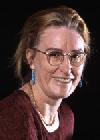

Inducted in 2008
Susan P. Fisher-Hoch speaks fluent French, and Italian, and some Spanish. She works as a professor of epidemiology in Brownsville, Texas, where she and her husband, Joe McCormick, established the new Brownsville campus of the UT School of Public Health in 2001.
At this institution, she created a research program in diabetes and tuberculosis recruiting and training a team of young scientists, mostly women. This program has attracted significant NIH funding and has made major advances in understanding these diseases in minority populations. She has established a molecular microbiology laboratory, with a BSL3 for handling pathogens such as Mycobacterium tuberculosis and West Nile Virus.
Meanwhile, she has over the years contributed many chapters to major textbooks, written review articles, reviewed for several journals, and has more than 100 major publications. With her husband, Joe McCormick she has published a popular account of their adventures (Level 4: Virus Hunters of the CDC) which has sold more than 70,000 copies, was translated into seven languages, and is widely read by young, aspiring scientists, particularly women.
Together, they have made invited presentations to students at institutions such as MIT, Duke, and Vanderbilt Universities.
Prior to her move to Texas, she and her husband had lived in France since 1997, where she took charge of the design, building, and scientific program of a new BSL4 space suit laboratory, financed by Charles Mrieux.
Susan was awarded the Chevalier de Legion d’Honneur by the President of France, Jacques Chirac. She also received Le Medaille de Lyon and Le Prix Scientifique du Group Paris-Lyon from the mayor and former Prime Minister of France, Raymond Barre, for her work in designing, constructing, and rendering operational the BSL4 laboratory of Lyon.
In 1993, Susan and her husband, who previously served as chief of special pathogens laboratory at the Center of Disease Control, moved to the Aga Khan University, Karachi, Pakistan, after their wedding in 1992.
Susan supervised the clinical microbiology laboratory, the largest in Pakistan. She established a molecular biology research laboratory and worked and published studies on pathogens such as hepatitis C, Congo Crimean Hemorrhagic Fever, tuberculosis, typhoid, and cholera.
In 1986, she was hired at the Center of Disease Control, where she remained for eight years, becoming Deputy Branch Chief, Special Pathogens Laboratory, Division of Viral Diseases, and serving as Acting Branch Chief.
Her responsibilities included primate studies of pathophysiology, vaccine evaluation, clinical and epidemiological advice for the United States and other countries, and supervision of the Sierra Leone Lassa Fever Research Unit.
She published several papers on topics like a Lassa Virus vaccine, comparative pathophysiology of Ebola isolates, and longitudinal studies of Ebola virus infections in monkeys.
Susan traveled widely and gained extensive experience working in China, Thailand, Indonesia, and several countries in Africa, conducting studies and publishing reports.
While with the CDC, she investigated outbreaks of Crimean Congo Hemorrhagic Fever in South Africa, Senegal, and Saudi Arabia, where she gave an invited lecture in Mecca.
She investigated devastating outbreaks of Lassa fever in Nigeria. She contributed to the investigation of the Reston, Virginia, outbreak in monkeys imported from the Philippines, visiting Indonesia and the Netherlands to try to track the source of the virus, and then returning to the laboratory to perform primate studies.
In 1984, she was initially invited to the CDC, Atlanta space suit BSL4 laboratory and published her findings on Lassa fever virus in the Journal of Infectious Diseases, providing key information on the pathophysiology of Ebola and Lassa viruses.
She had begun to study these diseases in 1982 when she obtained a Wellcome Trust Fellowship to study the pathophysiology of Ebola hemorrhagic fever in primates in the portion down BSL4 facilities using biological respirators. BSL4 is the highest level of containment that exists, used for the most dangerous viruses such as Ebola and Lassa. This fellowship allowed her to begin to understand the processes involved in shock and death in Ebola.
Between 1978 and 1982 Susan taught medical students, ran virology laboratories, and conducted research, publishing several papers. By 1981, she had a membership of the royal college of pathology in virology, a master’s degree in microbiology with distinction and a doctoral degree in epidemiology (MD) from London University. Her doctoral thesis findings were published in the Lancet and were the first identification of hot water systems as the source of outbreaks of Legionnaires disease, as opposed to air conditioning.
Susan also helped discover that the parvovirus B19 was responsible for Fifth's Disease (Slapped Cheek Syndrome) and participated in the first identification of E.coli O157 as the cause of the hemolytic uremic syndrome.
Before completing an internship with Dr. Sheila Sherlock at the Royal Free Hospital and joining the Radcliffe Hospital to train in virology, she graduated first class with seven prizes for excellence from the Royal Free Hospital school of medicine in 1975.
Susan gained admission to this fine establishment in 1970 at a time when women, particularly married women, were not offered places. At the Royal Free, she was awarded the Elizabeth Garrett Anderson fellowship.
After her internship with Dr. Sheila Sherlock at the Royal Free Hospital, she joined the Radcliffe Hospital, Oxford to train in virology. After completing high school, she attended the Sorbonne in Paris, then continued with linguistic and cultural studies in Rome.
University of Texas
Wikipedia
Researchgate